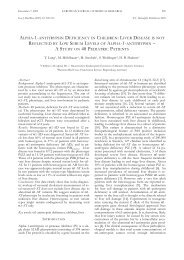European Journal of Medical Research - Deutsche AIDS ...
European Journal of Medical Research - Deutsche AIDS ...
European Journal of Medical Research - Deutsche AIDS ...
Create successful ePaper yourself
Turn your PDF publications into a flip-book with our unique Google optimized e-Paper software.
June 27, 2007 EUROPEAN JOURNAL OF MEDICAL RESEARCH<br />
95<br />
D.39 (Vortrag)<br />
Mitochondrial membrane potential <strong>of</strong> peripheral<br />
mononuclear cells in therapy naïve HIV infected<br />
patients<br />
Sternfeld T. 1 , Tischleder A. 1 , Schuster M. 1 , Bogner J. 1 ,<br />
German Competence Network HIV/<strong>AIDS</strong><br />
1 Medizinische Poliklinik, University <strong>of</strong> Munich, Department<br />
<strong>of</strong> Infectious Diseases, München, Germany<br />
Background: Mitochondrial toxicity was proposed to be<br />
caused by antiretroviral therapy (ART). We analyzed the influence<br />
<strong>of</strong> HIV infection on mitochondrial membrane potential<br />
(MMP) as a marker <strong>of</strong> mitochondrial function <strong>of</strong> peripheral<br />
mononuclear cells (PBMC) in patients without ART. The<br />
correlation <strong>of</strong> clinical and immunological parameters to MMP<br />
was investigated.<br />
Methods: We studied 58 HIV infected patients never treated<br />
with ART (mean CD4 cell count: 418/l, mean HI viral load<br />
VL 76.000 cp/ml, mean duration <strong>of</strong> known HIV infection 53<br />
months) and 8 HIV negative controls. MMP <strong>of</strong> PBMC was<br />
measured by flow cytometry using the lipophilic dye JC-1.<br />
Results: The mitochondrial membrane potential <strong>of</strong> HIV infected<br />
patients was significantly lower than for HIV negative<br />
controls (p=0.0001). In HIV infected patients, MMP <strong>of</strong><br />
PBMC was highly correlated to CD4 cell nadir (p=0.0001,<br />
r=0.5), CD4 cell count at baseline (p=0.014, r=0.3), percentage<br />
<strong>of</strong> CD4 positive cells (p=0.018, r=0.3), VL (p=0.001, r=-<br />
0.4), and time since first positive HIV test (p=0.03, r=0.3). In<br />
multivariate analysis, the CD4 cell count (p=0.001) and the<br />
time since first positive HIV Test (p=0.04) remained significant<br />
in contrast to HI viral load.<br />
Conclusions: HIV-infection itself has a significant influence<br />
on mitochondrial membrane potential <strong>of</strong> PBMC and is correlated<br />
to the immune status <strong>of</strong> the patient.<br />
D.40 (Vortrag)<br />
Lipoatrophy and ubiquitous mtDNA depletion in<br />
mice following long-term stavudine treatment<br />
Stankov M. 1 , Schmidt R.E. 1 , Behrens G. 1 , Competence<br />
Network HIV/<strong>AIDS</strong><br />
1 Hannover <strong>Medical</strong> School, Clinical Immunology, Hannover,<br />
Germany<br />
Background: Mitochondrial DNA (mtDNA) depletion has<br />
been proposed as an important factor leading to peripheral<br />
lipoatrophy in HIV-patients receiving antiretroviral therapy.<br />
The extent to which mtDNA depletion occurs in other organs<br />
and tissue in humans has not been evaluated and animal models<br />
for lipoatrophy have not been established so far.<br />
Methods: Groups <strong>of</strong> mice were treated with d4T, AZT or vehicle<br />
(5-20 mice per group) for up to 15 weeks with daily human<br />
doses adjusted for murine body surface area. In order to<br />
better parallel the pharmacokinetics in humans drugs were administered<br />
via oral gavage. MtDNA contend was determined<br />
by Real-Time PCR in liver, muscle, heart, brain, and fat tissue.<br />
Adiponectin and leptin were measured by ELISA in the<br />
serum.<br />
Results: Over a time period <strong>of</strong> 15 weeks mice receiving d4T<br />
or AZT gained less weight (d4T from 25.3±0.17g to<br />
29.1±0.2g; AZT from 25.8±0.2g to 30.2±0.2g) as compared to<br />
control animals (from 26.1±0.2g to 34.8±0.2g) while no differences<br />
in food and water intake were detected. Post mortem<br />
examination revealed that mice on AZT treatment but particularly<br />
animals receiving d4T had less <strong>of</strong> both peripheral as well<br />
as central fat. Similarly, d4T treated animals had lower serum<br />
adiponectin levels as compared to control mice (2.62±0.1<br />
g/ml vs. 3.05±0.1 g/ml; p





